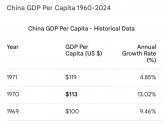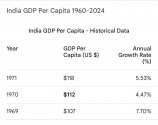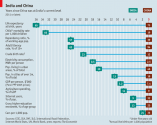Look at the two industries that the West is attacking in China:
1) EVs, China has the largest EV and the largest car market by a factor of two over the next challenger,
2) Chips, China is basically 50% of the global market
The chips part is old news. In the last few years, US has again become the largest semiconductor market in the world. A big reason being the insane demand for AI accelerators, along with reshuffling of supply chains.
I don't buy the demographics narrative. For decades, having a huge fast-growing population was a negative for development not a positive.
It was
considered negative for development, and that consideration has changed because of reality kicking in.
Also, through out entire history of humanity, big population was considered a good thing as they provided more people to farm, or fight. This only changed in the middle 19th century, when Europeans, supercharged with the Industrial Revolution, Enlightenment, and age of exploration, just took a very sizable early lead in Science, Technology, and Industry.
This made much larger countries like India, China being humiliated by much smaller countries like Britain. This coupled with the malthusian considerations and philosophy, made for an era where indeed huge population was considered a burden universally in the developing world including in India, China, Korea etc.
But this narrative was wrong, and 3 things happened that changed people's perspective:
- The horrors predicted by Malthusians never came to fruition. In fact, humanity is living a life of extreme indulgence. Agricultural output increased by 10x in some cases from 1900s. Malthusian considerations hence are no longer relevant.
- Economic, Scientific, and Industrial power became the main battlefields, and everyone realized that a domestic market, domestic GDP, etc. are the biggest resources a country can possess.
- The fertility and population growth declined by a lot, from a time of >5 to now below 1. This started hurting economic growth.
This was proven out in the 1960s and 70s when China, India, Nigeria, etc. had these immensely "favorable" demographics.
All of these 3 are totally different countries, with totally different cultures, histories etc. China in the 1950s was emerging from a brutal 100 years of constant war, struggle, and fighting. Obviously
In fact, in 1970, the fertity rate in China was 5.72(!!!) which rounds out to 6 kids per woman.
But China was piss-poor. As poor as India until its fertility rate began to reach first world standards.
Correlation is not equal to causation. So a high fertility rate is not equal to low development. And the fertility rate of today is not enough to even sustain the country for the long term, it's simply not enough.
The story of how a large growing young population is an advantage only changed in 2010s when China combined a high growth with a large population. Now it becomes a "good" thing because China was an exception.
Depends on what "advantage" means. Large population matters (and has always mattered) for aggregate heft, not per capita standards. Here we are discussing about total heft, not per capita.
If this young growing demographic advantage were real then Nigeria and every sub-Saharan country with that demographic advantage in the 1960s would be wealthier than Europe and Japan today, some 60 years after. Which we all know is not true.
You are confusing the demographic advantage people are talking about.
- Total size of the population is directly relevant for overall heft, not necessarily for per capita wealth.
- People are not talking about per capita GDP. If that was the case, maybe Luxembourg, or Norway would be the greatest power in the world.
- Culture, Institutions etc. still matter so don't just compare sub-Saharan Africa.
- Economic conditions also change, some countries take longer, some shorter. Sometimes it is because the policies are not okay.
The fact is low birth rate is a result of high development, high income and high GDP.
Not only. Modern culture, anti-natalism of the past half century, screwed up incentives, and in China's case, strict government regulations also play a part.
The only way for India to gain demographically on China in any significant way is to stay poor. If it becomes wealthy, it's birthrate would trend to same as China, Japan, Europe and the US.
Nope, India is already at a TFR of around 2, so yes it's trending that way. However, there's a huge difference in scale and timing. India's TFR is still twice that of China (which is a huge difference). And China's TFR has been low for over 2 decades now.
So, despite them following the same lower TFR path, it happens much later. Indian annual births today are already 2.5x that of China's.
This population despite having a lower TFR in the future, can still grow rich, even if they were to follow the same low TFR trajectory of others.
A China of even 1B (losing 400M) at the GDP per capita of Shanghai nationwide would be many times the size of the GDP today. The markets will grow by factors not by percentages from today.
And China won't age away 400M in our lifetime.
Except with current TFR trends it will. (at least I wish a long life for me).
China's annual births today are less than half of it's peak. The annual births today (if they were maintained with a TFR of 2.1 in the future), will give a long term population of only 700-800 million people.
And the TFR right now still continues to go down. By the end of the century, even if China maintains today's TFR, it will still have less than 800 million people. Read this paper:
The fertility trends and population trends in the paper that were followed in reality, are actually lower than the even the most pessimistic TFR projection. And the most pessimistic prediction is of 800M.
Also, these 800M people, probably >50% of them will be elderly. So they won't be the same 800M.
Today itself, >30% of Japan's population is over 65 years.
Are you okay with 700-800 M people (with current TFR, if it goes lower, than even worse), of which >50% are over retirement age?



